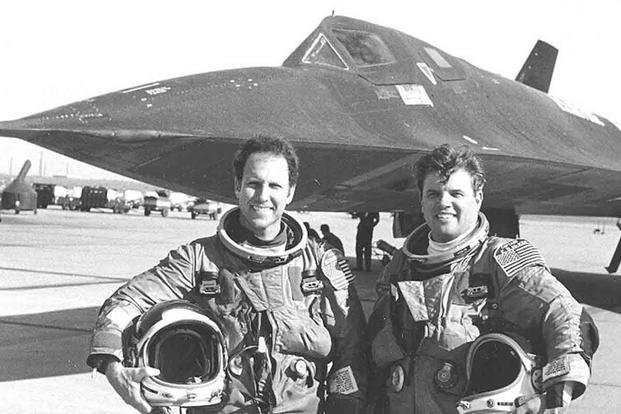
SR-71 Pilot Maury Rosenberg with RSO Ed McKim. (Western Museum of Flight)
Every Labour Day since 1946, Canada has held its International Air Show on the shores of Lake Ontario near Toronto. It’s an incredible display of Canadian, American and allied aircraft, bringing together the best of military and civilian aerospace technology.
1982 was a special year for the exhibition, because the crowd got a special visit from a rare sight: an SR-71 Blackbird flying so close, they could almost touch it. The real treat came for the Sacramento Airport, when the Blackbird made its return trip.
SR-71 pilot Maury Rosenberg spoke to a crowd at the Western Museum of Flight in 2018 about the characteristics of the SR-71 and what it was like to fly the plane, along with some anecdotes about his time flying it across the Soviet Union, Cuba and North Korea, just to name a few.

The SR-71 was the first titanium-built aircraft. It was designed to fly at high speeds and high altitude while using its array of sensors, cameras and other equipment to collect intelligence on areas other aircraft would not reach without substantial risks to the pilot and plane.
By 1982, Rosenberg had flown 220 combat sorties in the Vietnam War. He was one of the first pilots selected for “Wild Weasel” training, where American aircraft would intentionally be targeted by enemy surface-to-air missile (SAM) sites to reveal their locations. It would serve him well later over North Korea, when his SR-71 was targeted by a North Korean SAM.
At the Western Museum of Flight, Rosenberg recalled a story about requesting a “flyby” from the air traffic control tower in Sacramento. After performing with his SR-71 at the Canadian International Air Show, he flew the Blackbird back to Beale Air Force Base in California.

As he went to make his descent, he realized he had a lot of fuel left. He asked the “backseater,” his reconnaissance systems officer (RSO), whether he wanted to make an approach to nearby Sacramento.
“Can we do that?” the RSO asked.
“Why not?” was Rosenberg’s reply.
After heading toward the Sacramento Airport’s airspace, they switched communications to the tower at “Sac Metro.” As they got closer, they asked for an approach with their landing gear down. After the tower cleared them for an approach, Rosenberg asked whether they wanted a flyby down the runway or down the ramp.
The tower’s reply was an enthusiastic “down the ramp!”
Rosenberg put the landing gear up and then pushed the power up. As he flew toward the ramp and the tower, he rolled the plane away from the tower and lit the afterburner.
The SR-71 was capable of cruising at 2,200 mph, even at 85,000 feet. Each of its two Pratt & Whitney engines could produce 32,500 pounds of thrust. He later found out that passengers and personnel in the terminal threw themselves to the ground when he passed the tower, afterburners blazing.
Even so, the tower wanted the Blackbird to do it again. Rosenberg had to decline.

When he finally landed at Beale AFB, Rosenberg was met by his squadron commander in the hangar. His commander asked whether there were any regulations against making approaches to Sacramento Airport. Rosenberg replied that he didn’t know of one.
“I want one on my desk at 7 o’clock tomorrow morning,” the commander said.
Source: military.com








